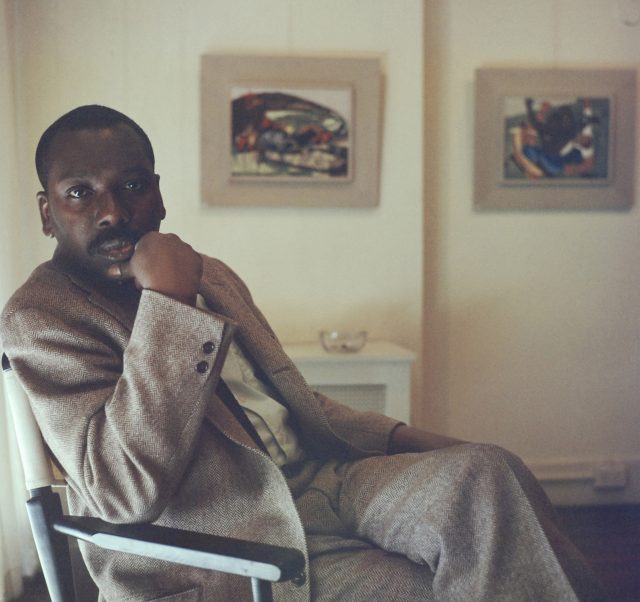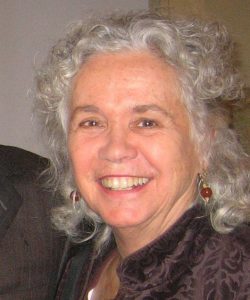
By Sydney Melson
The Birmingham Times
From his work capturing prominent Black historical figures, such as legendary abolitionists Harriet Tubman and Frederick Douglass, to the struggles of Black people migrating from the South to the North, Jacob Lawrence painted the intricacies of Black culture and rose to prominence as one of the most important artists in the 20th century.
For the past two months, the Birmingham Museum of Art (BMA) presented “Jacob Lawrence: The American Struggle,” an exhibition featuring a series of paintings through which the iconic artist depicts how women and people of color helped shape the founding of our nation.
The exhibit closes Feb. 7 and is the last chance to view the “Struggle” series which provides insight into Jacob Lawrence; how he became one of the 20th century’s most revered artists and his works still resonate.
Lawrence started working on the series—which he named “Struggle … from the History of the American People”—in the mid-1950s, during the height of the Cold War and anti-communism upheaval, said Patricia Hills, PhD, professor emerita, American and African American Art, in the Department of History of Art and Architecture at Boston University, who has authored several books and essays on 19th and 20th century art, including feminist and African American art.
According to Hills, Lawrence said the following about his “Struggle” series: “Right now, I’m reading [U.S. history], looking for any episode that suggests a symbol of struggle. The part the Negro has played in all these events has been greatly overlooked. I intend to bring it out. We were not just slaves before the Civil War. We were volunteers in all the wars. We played a great part.”
The panels in this series do not focus on the military generals but on the struggles of ordinary people, said Hills.
“Many panels represent the participation of Native Americans and women in the struggle for liberty and social justice,” said the professor, who wrote “Painting Harlem Modern: The Art of Jacob Lawrence in 2009.”
The paintings portray democratic debates that defined early America and remain poignant.
“In the tradition of artist-educators, Lawrence produced his ‘Struggle’ series to make history more rebellious, democratic, and complex in a manner that continues to resonate today,” said the curator of New York City’s Metropolitan Museum of Art, as quoted by Hills.
Lawrence’s work inspires a sense of unity and revolution, Hills said: “He brought real history alive in his paintings in the spirit of Karl Marx, who wrote in the 1848 Communist Manifesto: ‘Workers of the world unite. You have nothing to lose but your chains.’ Many artists today follow in Lawrence’s footsteps.”
The Migration Series
The last time Lawrence’s work was on display at the BMA was in 1994, when the museum presented “Jacob Lawrence: The Migration Series.” Portrayed in 60 panels, Lawrence captured the exodus of more than one million Black people from the South to the North. The simple, blocky shapes paired with bold colors, which Lawrence described as “dynamic cubism,” were inspired by the colors and shapes of Harlem. Hills said “The Migration Series” resonated with people.
“Anybody who was part of an immigrant experience, almost all Americans except for indigenous peoples, have been there,” she said. “Their ancestors were part of that migration experience. There were a lot of obstacles that [Lawrence] points out in the series that people recognized,” such as discrimination or denied access to transportation.
Born in 1917 Lawrence was the oldest of three children to Jacob and Rosa Lee Lawrence, “always admitted that he was a part of the Great Migration,” said Hills. “His parents were from the South: his father was from South Carolina, and his mother was from Virginia.”
His parents originally settled in Atlantic City, New Jersey. When they split in 1924, Lawrence and his siblings stayed with their mother and moved to Harlem, New York, five years later.
“[His] mother went off to work in Harlem because she felt that job prospects were better, so she left Lawrence and his two younger siblings in Philadelphia, [Pennsylvania], for a couple of years at foster homes,” Hills said. “So, already, he’s picking up a lot of experiences in this migration.”

Lawrence attended Public School 89 in Harlem, which was demolished in the 1960s. He also attended the Utopia Children’s Center, a facility in Harlem that provided after-school care and gave children the opportunity to participate in arts and crafts activities; well-known Harlem Renaissance painter Charles Alston ran the center.
In the mid-1930s, Lawrence met two other key Harlem Renaissance figures: sculptor Augusta Savage and historian Charles Seifert. The influences of Alston, Savage, and Seifert encouraged Lawrence to pursue his love of art.
“Alston always said Lawrence showed this fantastic talent for design, … and had a strong sense of color—dark colors and light colors—so he encouraged him,” Hills said. “Harlem was very progressive in those days. They taught about Black history, and Lawrence realized that the rest of the world wasn’t being taught African American history.”
Harlem Renaissance
Coming of age during the Harlem Renaissance—an era of astounding intellectual, social, and artistic activity in New York City’s Harlem neighborhood in the early 20th century—proved valuable for the talented Lawrence, who was in the midst of the cultural explosion along with creative giants, such as poet and playwright Langston Hughes and philosopher and writer Alain Locke.
“He was very much nurtured by the people in Harlem,” Hills said. “Locke loved Lawrence and his work, and really helped him get those grants and fellowships that funded his art projects. … [Other supporters included] the Garveyites, [supporters of Black nationalist leader Marcus Garvey, who sought to unify Black people around the world]; [people who were part of or sympathized with] the Communist Party; [people active with] different religious groups—all of those people trying to identify themselves as Americans.”
In 1937, Lawrence won a scholarship to attend the American Artists School in New York City. In that same year, he produced his “Toussaint L’Ouverture” series, which features 41 panels dedicated to the general who was the most prominent figure in the Haitian Revolution that led to the founding of the world’s first free Black republic.
One year later, Lawrence produced 40 panels for his “Frederick Douglass” series, which portrays the former slave turned national abolitionist leader in the 1800s. Among other series created by Lawrence are works dedicated to Harlem, World War II, and the struggles of Black people in the U.S.
“He did those paintings of famous people in African American history, but in all of them he tried to integrate. It wasn’t just about Blacks. It was about Blacks and whites working together,” Hills said.
Lawrence’s paintings on famous Black leaders led to his rapid success by the late 1940s.
“Lawrence was filling a niche. His style is cubism, which is flat planes of color, but it was an expressive cubism and a figurative cubism—and he was the one who could do it most successfully,” said Hills. “People were looking at his art, not necessarily at his race, and they were seeing these wonderful shards of blue, red, black, and gold intersection that gave his pictures a sort of dynamism that other pictures didn’t have.”
One of the first times Lawrence ventured away from the North was during a trip to New Orleans, Louisiana, in 1941 with his wife, Gwendolyn Knight, a renowned artist in her own right.
“They were newly married [and] went down to New Orleans—and they were shocked. The were not used to that kind of segregation, where Blacks had to ride on different parts of the bus or [were subject to] separate seating in restaurants,” she said.
Pressure of Discrimination
Lawrence also experienced discrimination in the South during his time in the Coast Guard and again when he was commissioned by Fortune magazine to paint “In the Heart of the Black Belt,” a series documenting Black life in the southern U.S.
“Of course, the whole country was segregated, but Harlem gave [Lawrence] a measure of self-confidence and freedom,” said Hills, noting that witnessing discrimination first-hand was something he felt deeply.
“He didn’t always vocalize it, but the emotion is there in his paintings,” she added.
Despite his elevated status as one of the most respected artists in the nation, Lawrence felt the pressure of discrimination.
“It was essentially tokenism, kind of like, ‘We’ll promote one Black person.’ Lawrence had the feeling that he had somehow been anointed,” Hills said. “Other artists who were struggling, like Alston, as well as painter Romare Bearden, were happy with [Lawrence’s] success, but they felt he was getting all the attention. He also saw his own friends and people he admired being on trial for their beliefs,” particularly in regard to communism.
Eventually, Lawrence found himself in a state of depression, for which he voluntarily admitted himself Hillside Hospital in Queens, New York, to recover.
In reference to Lawrence’s personal experiences, Hills points to panel 11 of the “Struggle” series, which depicts a man whispering into another man’s ear. The title of the panel is in reference to then-Gen. George Washington being betrayed by infamous Revolutionary War traitor Benedict Arnold.
“The panel clearly references informers to the FBI who were called as witnesses during the mid-1950s hearings of the House Committee on Un-American Activities and [U.S. Sen.] Joseph McCarthy’s Senate Permanent Subcommittee on Investigations, [each of which played a different role in pursuing people who were involved or sympathized with the Communist Party]. … Many of Lawrence’s friends were called to such panels of inquisition, and some had their careers ruined by informers,” Hills said.
Upon leaving Hillside Hospital in 1950, Lawrence worked in universities across the country, from New York to California. Eventually, he was offered a tenured position at the University of Washington in Seattle.
“Seattle really appreciated him,” Hills said. “He had a lot of really good students and, by all accounts, was a very beloved teacher in his calmness and guidance.”
Lawrence retired from his professor position in 1983 and died in 2000 of lung cancer. His works continue to be shared around the country.
“Jacob Lawrence: The American Struggle” will be on display in Birmingham Museum of Art’s Jemison Galleries through Feb. 7. For more information, visit artsbma.org.




